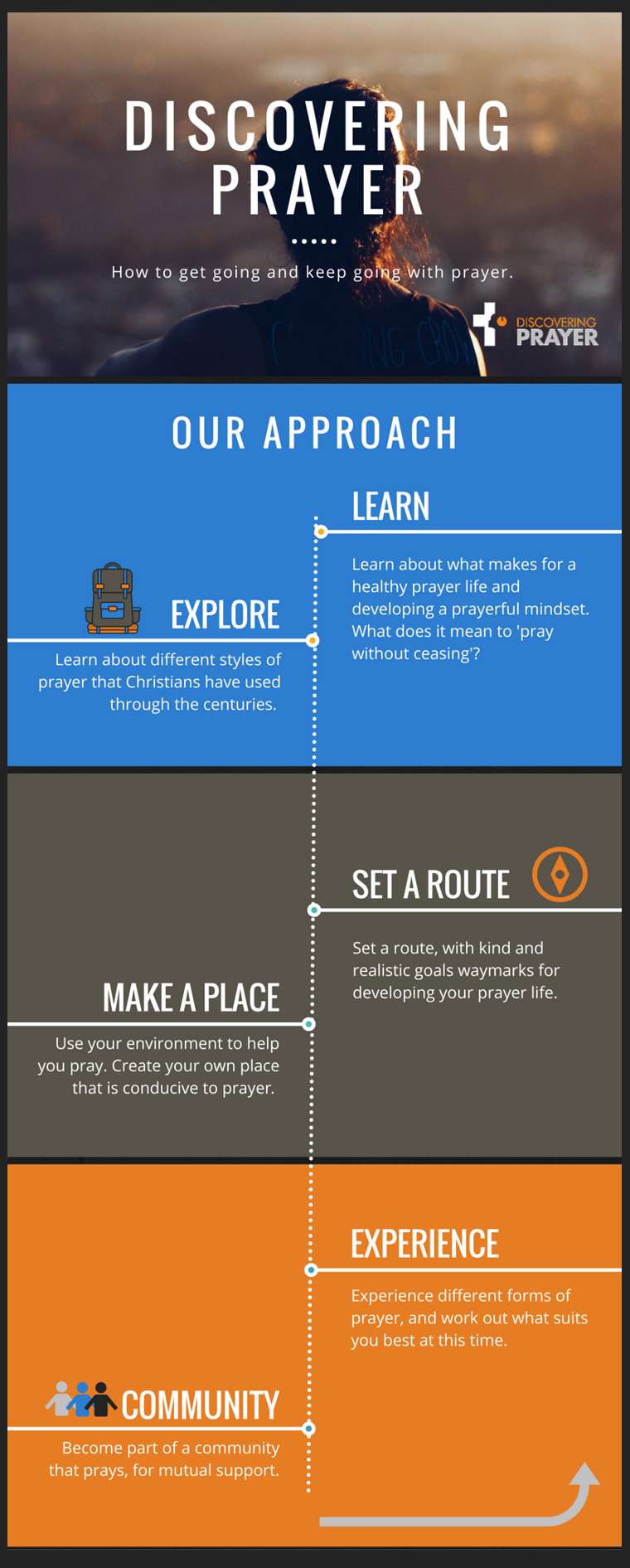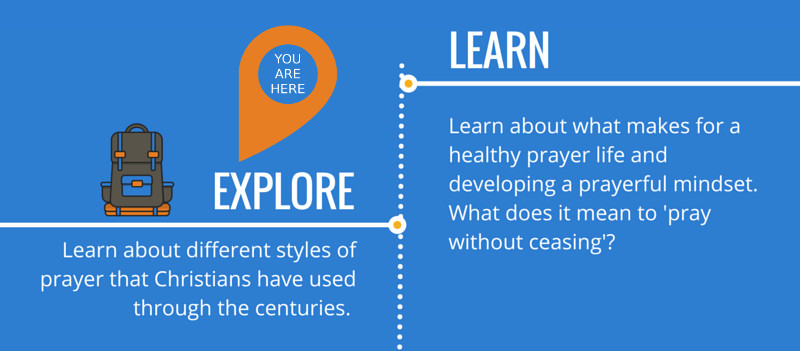Discovering Prayer's Approach

Our approach is to explore a range of methods of prayer that are rooted in the Bible and have been tried and tested for over 2,000 years. We learn from the wisdom of ancient Christians, and we apply modern psychology to understand how we can take up a new activity (in this case prayer) and stick with it.
The approach has worked for people exploring faith and for those who have been praying for years. This is because it:
- always starts where you are
- helps you define what it means for you to have a healthy prayer life
- equips you with what you need to get going and keep going with prayer.
Discovering Prayer is profoundly for everyone. We seek to follow the teaching and example of Jesus, and we believe that the Jesus story is compelling and useful for all people. We hope you will journey with us as we explore prayer together.
Start Where You Are

We are where we are. There is nowhere else we can be. Each person is unique in their own present level of faithfulness or exploration in prayer. So, before starting anything new, it is good to reflect on what God has been doing in your life to date.
The following awareness exercise and questionnaire will help you recognise the signs of God's presence and action in your life.
You can download the exercise, so you can print it and use it away from your computer if you prefer.
The following picture shows an overview of the Discovering Prayer approach. We will keep returning to it as we describe each step. You can also download it for printing as a reminder of the path we're following.
Below, we will cover the six steps in detail:
- learn about prayer
- explore different types of prayer
- work out a realistic route for praying
- create your own place for prayer
- experience different types of prayer
- join a community that prays, for mutual support.
Note the arrow after step six that points back up to the top. This approach is a means for continual discovery and re-discovery.

Let’s begin with...
Step 1 – Learn About Prayer
There hasn't been a lot of teaching on prayer in the modern Western world. And if you have had teaching on prayer, it probably only used one model or method.
Perhaps you've been told to use the Lord’s Prayer as a model, or to pray with a Bible or Bible commentary. Or perhaps you have been taught the nuts and bolts of how to pray. Our founder Michelle was taught to set a prayer time – preferably 30 minutes to an hour, usually in the morning – and to read the Bible and talk to God.
Of course, these are great things to do. It all sounds simple enough, and sometimes, with effort and discipline, we can keep going. But after a while the initial joy can seem to ebb away. We can be left wondering if we are going through the motions of prayer, with a nagging sensation that it should somehow be better than this.
What do we do then? Give up and feel guilty for not praying? Plod on feeling slightly unfulfilled? It doesn't sound much like Jesus' promise: 'I came that they may have life, and have it abundantly.' (John 10:10, NRSV)
Developing a broader, wider, deeper understanding of prayer

At Discovering Prayer we are committed to prayer. We're aiming to discover the breadth, length, height and depth of prayer, based on the riches of the whole Bible. We are particularly interested in the example of Jesus – how did he pray? And what does it mean when St Paul asks us to 'pray without ceasing'? (1 Thessalonians 5:17, NRSV)
In our journey of learning to pray, there are two key elements:
- a compass to point us in the right direction – developing a prayerful mindset
- food for the journey – having a balanced diet for prayer.
Let's have a closer look at each of these elements.
Developing a Prayerful Mindset
Our Father in heaven,
hallowed be your name.
Your kingdom come,
your will be done,
on earth as in heaven.
Give us today our daily bread.
Forgive us our sins,
as we forgive those who sin against us.
Lead us not into temptation,
but deliver us from evil.
For the kingdom,
the power and the glory are yours,
now and for ever.
Amen.
Let's first think about Jesus and prayer. How did Jesus pray? What did he teach about it?
We know that Jesus attended the synagogue for prayer, but at other times withdrew from the crowds to pray. He prayed with people for healing, and we know he prayed prayers of exclamation, thanking God publicly for things that had happened and glorifying God with his actions. He sometimes journeyed to mountain tops to pray, but at other times simply gave thanks for his food. His actions point to a life lived in reliance on God, that visibly sought to glorify God.
When his disciples asked Jesus to teach them about prayer, he told them not to show off, but to 'go into your room and shut the door and pray to your Father who is in secret' (Matthew 6:6, NRSV). He then gave us the prayer now sometimes called the 'Lord's Prayer' or the 'Our Father'. The Didache, some of the earliest Christian writing, suggests that early Christians were taught to pray this prayer three times a day.
A praying mindset is one based on the example that Jesus gave us and on his teaching. We pray as we are and to the best of our ability.
To exaggerate a little to get the point across… We're not locked into a prayer time once a day in a set location at a set time for a set duration, so we can tick it off as a job done!
The mindset we’re after in Discovering Prayer is to 'pray without ceasing', as Paul wrote.
It's about a life of continual prayer, the kind of prayer that underlies everything we are and do, and from time to time wells up into daily life. It builds our reliance on God, points towards God's glory, spills over into our work, our adoration, and whatever we are doing at any time.
It's also about a life of continuous learning in prayer, recognising that what might work for us when we are aged eight or 28 might not work for us when we are 88.
We are journeying together to learn how to pray without ceasing, praying in ways that are natural and simple, that are right at different times and occasions throughout the day.
What is a Healthy Diet for Prayer?

We need a balanced diet to feed the body, and we can also think in terms of a balanced healthy diet to nourish us on our journey of prayer. There are many different ways into prayer and methods of prayer. We have chosen five – the prayer equivalent of 'five a day' fruit and vegetables – to draw on and help us get into a healthy rhythm: the Lord’s Prayer, mini prayers, scripture, adoration and thanksgiving, and silence.
We have already suggested that prayer can be thought of more broadly than a one-off prayer time, and that we can include our 'five a day' in our lives as part of a way of learning to pray without ceasing.
For example, we might deliberately decide to pray the Lord's Prayer at certain times of the day, really listening to the words. We might learn some short prayers to say, as well as making up our own. We might have regular or spontaneous times of adoration and thanksgiving, recognising God as the source and foundation of our being and doing, in small tasks or bigger projects.
We might seek to study and learn from the Bible, sometimes simply slowing down when we read, or we might read books that help us to grow in our understanding. We might also want to incorporate some silence into our lives, deliberately turning off the TV or radio in order to listen in the quiet, to God and to ourselves before God.
Beware! As you read this, please don't imagine this is a difficult process full of 'oughts'. 'Five a day' is an easy shorthand. We're not telling you to use all five every day. The idea is to gently learn and explore the five different types of prayer. We aim to follow the prompting of the Holy Spirit, recognising that we won't always get things right, but trusting that in time God will guide us.
If you'd like to learn more about these ways of praying, you can sign up for our free Discovering Prayer Course.
Step 2 – Explore different types of prayer

The next step is to choose a style of prayer that’s right for you and your lifestyle as it is now. It is sometimes news to us that there are so many ways to pray. We have found that the best type of prayer for us changes at different times in our lives.
Learning from Ancient Paths
Christians throughout the centuries have been immersed in different ways of prayer. Some of these paths can be helpful for us today. They usually combine prayer with the use of scripture, and help us to keep focused on God.
Here are brief descriptions of the five ways of prayer that form part of our Discovering Prayer Course. If you would like to see whether they help you in your prayer, do go ahead and try out the free, two-week Discovering Prayer Course.
Absorbing God’s Word
Absorbing God’s Word is a practice adopted very early on. Its origins were in the third to fourth centuries. It was popularised from the sixth century by the monastic communities that lived under the Rule of Benedict, and Benedictine communities still use it today. It simply involves slowly reading scripture – usually using the story and teachings of Jesus found in the Gospels. If a phrase or word particularly strikes you while reading, you stay with that piece of scripture, repeating it to yourself to allow it to sink in. You don't try to analyse the scripture. After a time, when your mind begins to wander (as all minds do), you start talking to God or Jesus about this piece of scripture. Finally, you allow your mind to calm, and gently move into a time of silent adoration.
Praying with Imagination
Praying with Imagination draws on the spirituality of Ignatius of Loyola, who founded a community of Christians in 1540. They lived lives of prayer and service, not as monks in a monastery, but as religious brothers, sisters and ministers who were ‘contemplatives in action’. They are referred to as Jesuits, which means society or community of Jesus.
Ignatius' teaching on prayer encourages us to look for God in our daily lives – where God is and how God is working. He offers us a specific form of prayer that enables us to use our imaginations to experience being with Jesus.
Listening to God
Christians sometimes think of meditation as listening to God – stopping all our talking to God in our minds, and listening in silence in the hope and expectation that God will speak clearly and we will truly hear and understand. Listening prayer is part of being in a relationship with God. When we are with a person we love, we sometimes just hold hands and rest in each other's presence, and that’s enough. So it is with God. The act of surrendering our thoughts does in fact deepen our relationship with God. Silence and listening to God have a place in Christian prayer as part of a whole pattern of life and worship. Silent meditation in Christianity is never an end in itself, which is a critical difference from mindfulness and other forms of modern meditation.
Praying Through the Day
The ancients knew a thing or two about prayer. They had been with Jesus and they’d seen him often pray at different times in the day. The Psalms were his prayer book – he often quoted from them – and they really express everything life can throw at us.
In Psalm 55 there is an example of prayer three times a day: 'Evening and morning and at noon I utter my complaint and moan, and [God] will hear my voice' (Psalm 55:17, NRSV). Combined with Jesus' teaching on prayer, perhaps that's why the early Christians suggested in the Didache to pray the Lord’s Prayer three times a day.
Psalm 119 goes further: 'Seven times a day I praise you, Because of Your righteous judgments” (Psalm 119:164, NKJV). Religious communities of monks and nuns took this example literally, and turned it into a structure for praying through the day. The seven short services during the day are called the Daily Office, and they are based on the Bible and especially the Psalms. But this is probably a bit ambitious in normal daily life!
Step 3 – Work out a realistic route for praying

Some parts of the Bible refer to our walk with God as running a race, with the notion that we need to put some effort into our lives for them to be fruitful – for example, 'let us run with perseverance the race that is set before us, looking to Jesus the pioneer and perfecter of our faith' (Hebrews 12:1, NRSV). Just so, in our lives of prayer, there is some effort required. Too little effort means we won’t get started. But too much and we will wear ourselves out and give up.
So as we begin to think about working out realistic waymarks along our way to becoming more prayerful, we need to aim for balanced goals, what occupational therapists call 'achievable challenges'. Michelle recently learned to jog by taking the ‘Couch to 5K’ programme. This starts off with a very modest one-minute jog followed by a minute of walking (repeated), yet in just six weeks she found herself running 5k, hardly noticing the gradual increase in effort as her body adjusted to the challenge.
We can also learn from popular psychology. For example, in his book The Chimp Paradox, Professor Steve Peters tells us it is better to set small goals – like getting up ten minutes earlier – rather than overdoing it and putting ourselves off. We can always extend ourselves later once we have felt the benefits of easier goals.
In applying this kind of thinking to your own prayer life, you might consider what would be an easy goal for having a prayer time. What is realistic in your lifestyle now? Can you have a regular prayer time daily, or do you need a routine that changes throughout the week? Perhaps a slightly longer prayer time once a week would be more realistic than a short time every day. Do you have time to spend on your own in prayer? If not, could you regularly pray on a walk or whilst doing chores?
Think about making a very small goal for this week. It might help to share this with another person. Or you could share it on Discovering Prayer's Facebook page, so others taking part can pray with and for you.
Step 4 – Create your own place for prayer

One of the first books Michelle read about prayer taught her to make a special place for prayer and to return to it. This is the same concept as keeping churches, chapels and cathedrals as special places of prayer. When we enter, they somehow immediately evoke for us a sense of God’s presence. Some people we know choose their bedroom, as a private space where they won’t be disturbed. Others have a special chair for prayer, or keep a prayer board of people to pray for. Christine Sine’s book Godspace has lots of suggestions for making a place for prayer.
This is all very well for those who have the time, space and finance to create a special place in their home. But what if we can’t create a physical place? One possible answer is to spend a day or two saying small prayers as you go about your daily life, simply remembering to pray when you can.
On the other hand, you may find you just can't pray at home. Other places may be more helpful: a church that is open nearby, or a walk in nature. Try places out and find one that works for you.
Step 5 – Experience different types of prayer

The experience of prayer can vary widely for each person and from year to year or even day to day. We can have times when prayer seems to flow. It can feel effortless and God seems close. At other times we can feel very much alone and full of doubts. All this is part of prayer. One of the nuns who contributes to Discovering Prayer says that even when we have times of prayer that seem dry, in which nothing seems to ‘happen’, even then, at a deeper level our soul is communing with God and being slowly transformed. It's not a question of what prayer ‘feels’ like, but more a sense of growing in trust and faith.
It can help to have a trusted friend to pray with and to talk to openly about prayer. This might be a church leader or minister, or a spiritual director. It is good to explore our experience of prayer with another person, and to learn from those a little further along the road. Often they can help us discover where God is in our lives.
It can also help to have a bit of a prayer boost by going on retreat. This is a period when we withdraw from our normal routines and set time aside for thinking and praying about God. People who need more silence may find a retreat house a more natural place for retreat, and convents and monasteries usually have rooms for guests. You can slot into the routine of a praying community, and still have lots of time alone to reflect. Alternatively, although many people might not think of big Christian festivals as places of retreat, gatherings like Greenbelt and Spring Harvest can be great times to withdraw from routines and set time aside.
Step 6 – Join a community that prays, for mutual support

Jesus said that, 'where two or three are gathered in my name, I am there among them' (Matthew 18:20). We are encouraged to pray together, and when we do, something more seems to happen. We're like a flock of migrating birds that need each other in order to make the journey. Even Jesus didn’t live his life and carry out his ministry alone. He was part of a group. When he was busy with his work, he often sought the company of friends outside the noise of the big city, perhaps to recharge his batteries. See for example Mark 11:11, when he left Jerusalem with his disciples to spend the night at Bethany.
That’s one of the reasons for being part of a church and it’s one of the reasons for praying with others. We seem to be created to be in a community with others. You may be surprised to hear that when Michelle was a novice in a community of nuns, she had little teaching on prayer. She did have access to a wonderful library and read extensively about prayer, but no one taught her what to do. The nuns’ way was to get on with living a balanced life of prayer, worship, work, rest and fellowship. They prayed alone and worshipped together every day, and allowed God to teach them according to his purpose. They expected the novices to learn to pray not by being taught but by experiencing prayer, together, and by learning to love one another in community.
There are often people using the Discovering Prayer website to pray – praying together even though far apart geographically. It has been our experience that this sense of praying together is one of the key aspects of what we offer to everyone.













